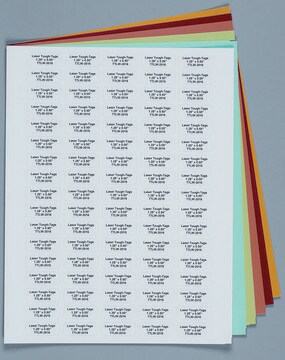일반 설명
We are committed to bringing you greener alternative products, which adhere to one or more of The 12 Principles of Green Chemistry.This antibody is Preservative-free, produced without the harm or sacrifice of animals and exceptionally stable to allow for ambient shipping and storage if needed and thus aligns with "Waste Prevention", "Designing Safer Chemicals" and "Design for Energy Efficiency".
Click here for more information.
ZooMAb® antibodies represent an entirely new generation of recombinant monoclonal antibodies. Each ZooMAb® antibody is manufactured using our proprietary recombinant expression system, purified to homogeneity, and precisely dispensed to produce robust and highly reproducible lot-to-lot consistency. Only top-performing clones are released for use by researchers. Each antibody is validated for high specificity and affinity across multiple applications, including its most commonly used application. ZooMAb® antibodies are reliably available and ready to ship when you need them.
특이성
Clone 10H11.2 is a ZooMAb® mouse recombinant monoclonal antibody that specifically detects Oct-4. It targets an epitope within the N-terminal region.
면역원
GST-tagged recombinant fragment corresponding to first 124 amino acids from human Oct-4.
애플리케이션
Quality Control Testing
Evaluated by Western Blotting in NTERA2 cell lysate.
Western Blotting Analysis: A 1:1,000 dilution of this antibody detected Oct-4 in NTERA2 cell lysate.
Tested Applications
Western Blotting Analysis: A 1:1000 dilution from a representative lot detected Oct-4 in Neuro2a cell lysate.
Immunocytochemistry Analysis: A 1:100 dilution from a representative lot detected Oct-4 in NTERA2 cells.
Flow Cytometry Analysis: 1 µg from a representative lot detected Oct-4 in one million NTERA2 cells.
Immunohistochemistry (Paraffin) Analysis: A 1:100 dilution from a representative lot detected Oct-4 in Human seminoma tissue sections.
Note: Actual optimal working dilutions must be determined by end user as specimens, and experimental conditions may vary with the end user.
표적 설명
POU domain, class 5, transcription factor 1 (UniProt: Q01860′ also known as Octamer-binding protein 3, Oct-3, Octamer-binding protein 4, Oct-4, Octamer-binding transcription factor 3, OTF-3) is encoded by the POU5F1 (also known as OCT3, OCT4, and OTF3) (Gene ID: 5460) in human. Oct-4 is a transcription factor that binds to the octamer motif (5′-ATTTGCAT-3′). It forms a trimeric complex with SOX2 on DNA and controls the expression of several genes involved in embryonic development such as YES1, FGF4, UTF1 and ZFP206. It is shown to be critical for early embryogenesis and for embryonic stem cell pluripotency. It is highly expressed in undifferentiated embryonic stem cells and its expression decreases gradually after embryoid body (EB) formation. In humans, two isoforms of Oct-4 have been described that are generated by alternative splicing. The isoforms, Oct-4-IA (360 amino acids) and Oct-4-IB (265 amino acids) have identical C-terminal (225 amino acids) but differ in sequence at their N- terminal region. It has been reported that Oct-4-IA is essential to sustain stem cell self-renewal and Oct-4-IB is not related to stemness. Oct-4 contains a POU-specific domain (aa 138-212) that mediates its interaction with pyruvate kinase isozyme type M2 (PKM2), which regulates its transcriptional activity in as positive manner. Human Oct-4 can undergo phosphorylation by protein kinase A and/or ERK at a highly conserved serine 236 within the POU DNA-binding homeodomain. Phosphorylation at this site sterically hinders both its DNA binding and homodimer assembly. Oct-4 can undergo sumoylation that enhances its stability, DNA binding and transactivation activity. WWP2, an E3 ubiquitin ligase is shown to specifically interact with Oct-4 through its tryptophan-based WW domains, which promotes its ubiquitination and proteasomal degradation. This ZooMAb® recombinant monoclonal antibody, generated by our propriety technology, offers significantly enhanced specificity, Affinity™, reproducibility, and stability over conventional monoclonals. (Ref.: Zeineddine, D., et al. (2014). Am. J. Stem Cells. 3(2);74-82; Lee, J., et al. (2008). Int. J. Biochem. Cell Biol. 40(5); 1043-54).
물리적 형태
Purified recombinant mouse monoclonal antibody IgG, lyophilized in PBS, 5% Trehalose, normal appearance a coarse or translucent resin. The PBS/trehalose components in the ZooMAb formulation can have the appearance of a semi-solid (bead like gel) after lyophilization. This is a normal phenomenon. Please follow the recommended reconstitution procedure in the data sheet to dissolve the semi-solid, bead-like, gel-appearing material. The resulting antibody solution is completely stable and functional as proven by full functional testing. Contains no biocide or preservatives, such as azide, or any animal by-products. Larger pack sizes provided as multiples of 25 µL.
재구성
300 µg/mL after reconstitution at 25 µL per vial. Please refer to guidance on suggested starting dilutions and/or titers per application and sample type.
저장 및 안정성
Recommend storage of lyophilized product at 2-8°C; Before reconstitution, micro-centrifuge vials briefly to spin down material to bottom of the vial; Reconstitute each vial by adding 25 µL of filtered lab grade water or PBS; Reconstituted antibodies can be stored at 2-8°C, or -20°C for long term storage. Avoid repeated freeze-thaws.
기타 정보
Concentration: Please refer to the Certificate of Analysis for the lot-specific concentration.
법적 정보
Affinity is a trademark of Mine Safety Appliances Co.
ZooMAb is a registered trademark of Merck KGaA, Darmstadt, Germany
면책조항
Unless otherwise stated in our catalog or other company documentation accompanying the product(s), our products are intended for research use only and are not to be used for any other purpose, which includes but is not limited to, unauthorized commercial uses, in vitro diagnostic uses, ex vivo or in vivo therapeutic uses or any type of consumption or application to humans or animals.






